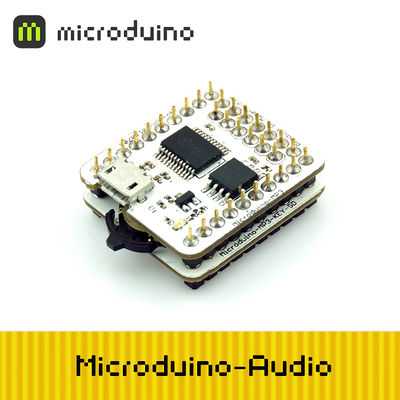Microduino-Audio
1304410487@qq.com(讨论 | 贡献)2014年11月6日 (四) 06:14的版本 (Created page with "{{Language|Microduino-Audio}} {| style="width: 800px;" |- | 400px|thumb|right|Microduino-Audio Microduino-Audio is the audio play module ba...")
| Language | English |
|---|
|
Microduino-Audio is the audio play module based on JQ6500 serial port MP3 chip, which together with Audio-KEY-SD can play flash music by thumbwheel switch control and with Microduino core module can send serial port commands to control the system.
目录Features
Specification
DocumentJQ6500 sound chip description: 文件:JQ6500.pdf Development
byte key0[5] ={0x7E,0x03,0x09,0x01,0xEF};//device select "tf" U/TF/AUX/SLEEP/FLASH 00-05
byte key1[5] ={0x7E,0x03,0x11,0x00,0xEF};//play mode "all" ALL FOL ONE RAM ONE_STOP 00-05
byte key2[4] ={0x7E,0x02,0x0d,0xEF}; //play 7E 02 0D EF
byte key3[5]={0x7E,0x03,0x06,0x18,0xEF};//vol 24 0-1E(0-30)-16,8,4,2,1
void setup()
{
Serial.begin(9600); // 9600 bps
delay(300);
for(int a=0;a<5;a++)Serial.write(key11[a]); //vol 18
delay(300);
for(int a=0;a<5;a++)Serial.write(key0[a]); //tf card
delay(300);
for(int a=0;a<5;a++)Serial.write(key1[a]); //play all
delay(600);
for(int a=0;a<4;a++)Serial.write(key3[a]); //play
delay(600);
}
void loop()
{
}
Program Description:
ApplicationMicroduino-Audio is widely used in various kinds of voice broadcast:
PurchaseHistoryPictureFront文件:Microduino-Audio-F.JPG Microduino-Audio Front Back文件:Microduino-Audio-b.JPG Microduino-Audio Back Video |
